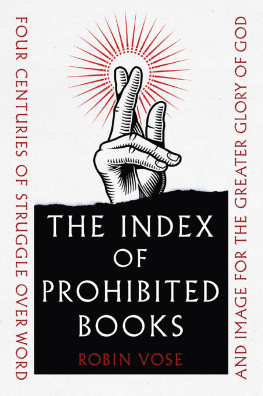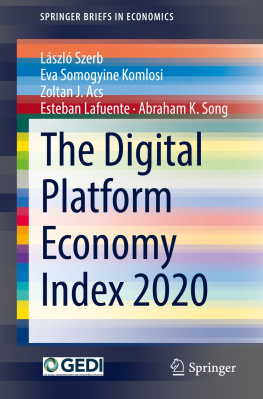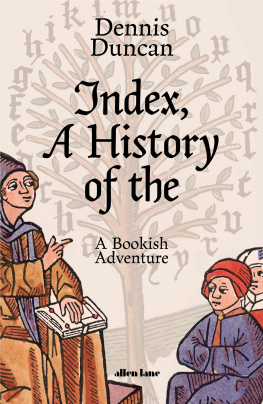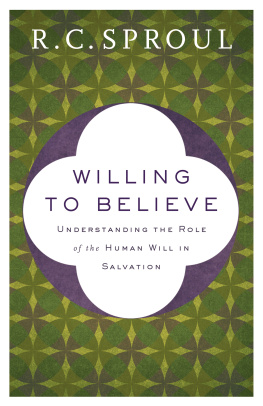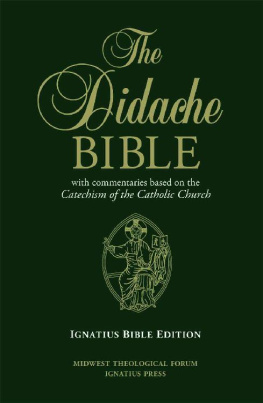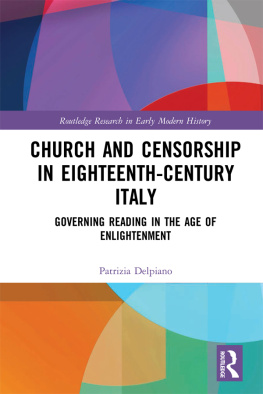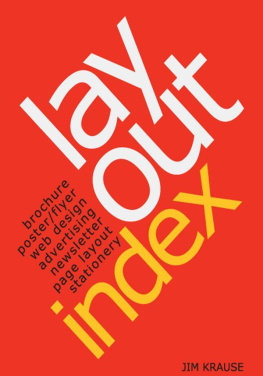THE INDEX
OF
PROHIBITED
BOOKS

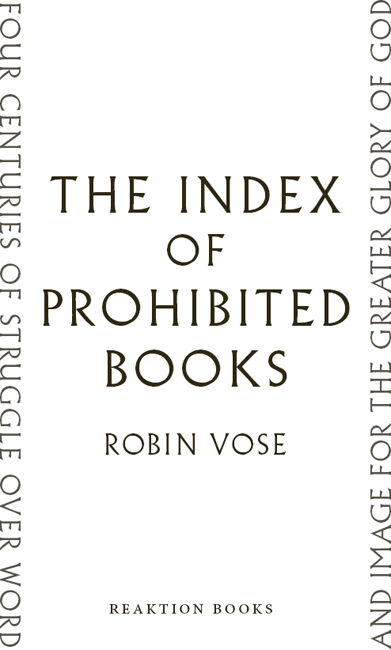
For Milo Robin Carlos Gomes Jones, in celebration of his third year of lightening our hearts
Published by Reaktion Books Ltd
Unit 32, Waterside
4448 Wharf Road
London N1 7UX, UK
www.reaktionbooks.co.uk
First published 2022
Copyright Robin Vose 2022
All rights reserved
No part of this publication may be reproduced, stored in a retrieval system, or transmitted, in any form or by any means, electronic, mechanical, photocopying, recording or otherwise, without the prior permission of the publishers
Page references in the Photo Acknowledgements and
Index match the printed edition of this book.
Printed and bound in Great Britain
by TJ Books Ltd, Padstow, Cornwall
A catalogue record for this book is available from the British Library
eISBN 978178914658
CONTENTS
INTRODUCTION
T his book is a study of a very particular institution, first established in the sixteenth century of the Common Era (CE) as a means of preventing the spread of objectionable religious ideas within the Roman Catholic communities of Europe. That institution, the Index librorum prohibitorum or Index of Prohibited Books, primarily took the form of printed lists of books and authors that Church officials wanted to keep away from all but the most carefully selected and qualified expert readers. It was thus essentially a tool, a technology of censorship, designed to achieve a certain goal in a specific context. Like all tools, it maintained certain basic characteristics while also being modified over time to better serve its purpose(s). This was especially true as the objectives and circumstances of its wielders evolved and spread to new lands. Such shifts and continuities, the very stuff of which history is made, are fascinating in and of themselves.
No further justification is needed to write a book. My task in the chapters that follow is therefore in some ways quite simple: to tell the story of how and why, over a period of almost exactly four centuries, Catholic authorities designed and deployed various forms of Index as a means of enforcing one particular system for the censorship of words and images.
But this is also a very complicated undertaking, since we are talking about arguably the most important, longest-lived and least understood institutional exercise in censorship that has ever been attempted. At some times and in some places, it did incalculable harm to the history of human creativity. It was also in many ways a failure right from its awkward beginnings to its surprisingly late end. And it was never only a means of persecuting those who had been identified as enemies of the Church; nor was it ever simply the blunt instrument of anti-intellectualism, aimed at the generalized suppression of all forms of free thought, that it is sometimes depicted as in caricature. It could even be argued that the Index served as a positive force in some contexts, or at least a well-intentioned effort, for the honest discernment of good from bad spiritual, intellectual, literary and cultural productions in modern terms, by distinguishing between art and trash, debunking junk science and charlatans, muting fake news and so on. At its best, when directed by some of the worlds most brilliant scholars, this censorship was in fact much less arbitrary or heavy-handed than is often supposed. In such instances it was not really all that far from (and perhaps even more transparent than) modern practices of academic peer review, or the many ways in which our own media experiences are dictated by Internet algorithms.
Whatever our final modern judgements may be, the legacy of the Index of Prohibited Books is richly deserving of close critical scrutiny so that we can better understand precisely what actually happened over its long history, and how it happened and why. Hopefully we can learn from some of the mistakes and excesses of the past in this regard especially as we contemplate how best to navigate the far more effective, ubiquitous, and insidious systems of digital-era censorship that already envelop us.

BEFORE EMBARKING ON an exploration of just what the Index was (or rather what the many different Indexes were, along with the complex institutional frameworks, policies and supplementary documentation that supported them), it might also be helpful to explain some of the limits to this study. Like all historical phenomena, the Index existed in a context that shaped its development and the ways in which it was perceived by contemporaries. This wider context must be acknowledged as much as possible, but obviously not everything can be covered in a single book. For example, while it is important to recognize that the Catholic Church was far from unique in its censorship efforts (which extended beyond the Index itself), I will not attempt to fully explore the equally fascinating and complex details of parallel censorship by secular authorities. In each of the countries in which it operated, the Churchs ability (and perceived need) to censor materials was limited to a greater or lesser extent by royal, parliamentary or other secular jurisdictions that similarly sought to prevent the circulation of offensive writings or images. We should therefore not assume that just because a text failed to appear on the Index, it had free rein in every kingdom; in fact, some texts never reached the Index compilers precisely because they had previously been suppressed by order of a king or queen, or by their ministers and agents.
For the most part, however, these long and knotty histories range far beyond the scope of the present book.
Strictly speaking, the term Index of Prohibited Books is used here to designate only those published and formally recognized censorship lists that were duly authorized as such by an established hierarchy of the Roman Catholic Church. Their exact title could vary: sometimes simply Cathalogus librorum (Spain, 1559), sometimes Index et catalogus librorum prohibitorum (Spain, 1583); or even Index auctorum, et librorum, qui tanquam haeretici, aut suspecti, aut perniciosi, ab officio sancta Romanae inquisitionis reprobatur, et in universa Christiana republica interdicuntur (Index of Authors, and Books, which have been Condemned by the Holy Office of the Roman Inquisition and Forbidden in all Christendom as Either Heretical, or Suspicious or Pernicious, Rome, 1557). They might be compiled and issued by various branches or representatives of the Church, including not only popes and regional inquisitions but bishops and university departments of theology. These collections of titles and authors names were also supplemented from time to time by singular edicts banning one or more author, written work or image. And while books were their main focus, other forms of writing were also occasionally addressed, so that later Index literature included consideration of newspapers, magazines and pamphlets as well. Certain types of images were banned on a regular basis, and ancillary documentation prepared by the various inquisitions or papal offices could eventually condemn everything
My challenge will be to coherently examine all these disparate yet related documents as a whole phenomenon, in order to fully understand how the Catholic Church sought to achieve a totalizing goal that ultimately had to be abandoned as overly ambitious: absolute control over the spiritual and ideological content of written and other forms of communication that audiences of the faithful might be exposed to throughout their lives.

